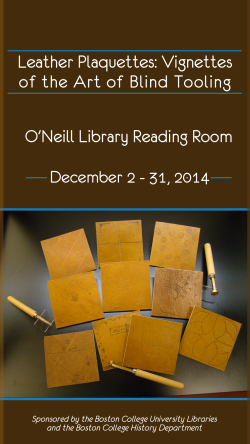The members of Professor Virginia Reinburg's class, Early Printed Books: History and Craft, produced the designs ornamenting each of the leather plaquettes featured in this exhibit. The course, taught at the Burns Library and in collaboration with the staff there, principally the conservator Barbara Adams Hebard, explores the print culture that developed in early modern Europe in the centuries immediately following Johannes Gutenberg's famed invention. Of course, the class also focuses on the craft of bookbinding as it existed in those same centuries.
Blind tooling, the technique demonstrated here, is part of the finishing process, whereby the bookbinder impresses on the leather a design and perhaps the title of the volume bound. This is done by heating the specialized instruments also exhibited here and stamping them, with some force, onto the leather surface. The tools were, and still are, expensive, so often bookbinders possess only a few, which they use rather imaginatively to create a variety of patterns. Early bookbinders, however, did not typically approach the task with a concern for precision or a desire for perfection. Hence, some of the more exacting designs on display are more reminiscent of the nineteenth-century blind tooling techniques employed by bookbinders like T. J. Cobden-Sanderson, who was influenced by the accuracy of new machine-made designs, products of the industrial revolution.
The exhibit is sponsored by the Boston College University Libraries and the Boston College History Department.

